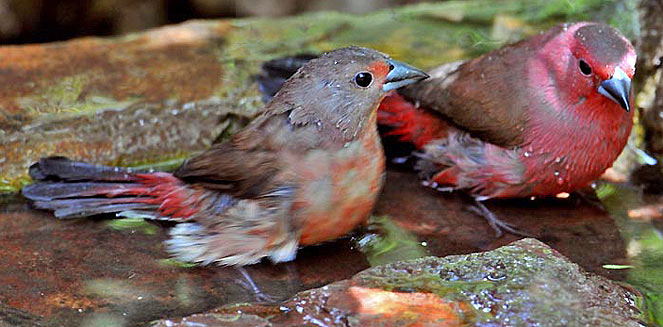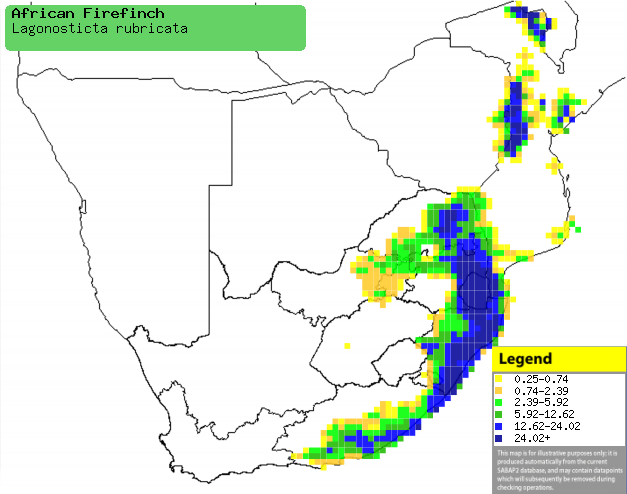|
Lagonosticta rubricata (African
firefinch, Blue-billed firefinch)
Kaapse vuurvinkie [Afrikaans]; Isicibilili [Xhosa];
ubuCubu [Zulu]; Donkerrode amarant [Dutch]; Amarante foncé [French];
Dunkelroter amarant [German]; Peito-de-fogo-de-bico-azul [Portuguese]
Life
> Eukaryotes >
Opisthokonta
> Metazoa (animals) >
Bilateria >
Deuterostomia > Chordata >
Craniata > Vertebrata (vertebrates) > Gnathostomata (jawed
vertebrates) > Teleostomi (teleost fish) > Osteichthyes (bony fish) > Class:
Sarcopterygii (lobe-finned
fish) > Stegocephalia (terrestrial
vertebrates) > Tetrapoda
(four-legged vertebrates) > Reptiliomorpha > Amniota >
Reptilia (reptiles) >
Romeriida > Diapsida > Archosauromorpha > Archosauria >
Dinosauria
(dinosaurs) > Saurischia > Theropoda (bipedal predatory dinosaurs) >
Coelurosauria > Maniraptora >Aves
(birds) > Order: Passeriformes
> Family: Estrildidae
 |
|
African firefinch female (left), and male (right).
[photo
Callie de Wet ©] |
Distribution and habitat
Occurs in patches across sub-Saharan Africa, from Senegal
to Ethiopia south through southern DRC and Tanzania to southern Africa. Here it
is locally common in Zimbabwe's eastern highlands and adjacent Mozambique, with
a separate population from the Eastern Cape through KwaZulu-Natal to Swaziland
and north-eastern South Africa, extending into southern Mozambique. It generally
prefers moist, densely vegetated habitats such as bracken (Pteridium
aquilinum) at the edge of forest and rank grass with tangled undergrowth
along watercourses, often near paths or quiet roads; it also occupies gardens
and rural villages.
|
 |
|
Distribution of African firefinch in southern
Africa, based on statistical smoothing of the records from first SA Bird
Atlas Project (©
Animal Demography unit, University of
Cape Town; smoothing by Birgit Erni and Francesca Little). Colours range
from dark blue (most common) through to yellow (least common).
See here for the latest distribution
from the SABAP2. |
Food
It mainly eats seeds supplemented with insects, doing most
of its foraging on the ground, sifting through soil in search of food. The
following food items have been recorded to be eaten in captivity:
- Seeds
- Eragrostis tef (Teff grass)
- Eragrostis lehmanniana (Lehmann's lovegrass)
- Setaria verticillata (Bur bristle grass)
- Hyparrhenia hirta (Thatching grass)
- Panicum (guinea grasses)
- Insects
Breeding
- The nest is built by the male, consisting of a ball-shaped structure with
a side entrance, made of long, dry grass blades and with an inner shell of
soft grass inflorescences, sometimes lined with feathers. It is typically
concealed in dense grass, bracken-brier undergrowth or in a tuft of grass
growing out of a fallen branch or tree stump, about 0.5-2.0 metres above
ground.
- Egg-laying season is from November-June, peaking from January-April.
- It lays 2-5 eggs, which are incubated by both sexes for about 11-12
days.
- The chicks are fed both parents and leave the nest after about 14-19
days, after which they are fed for 10 more days, after which they soon
become fully independent.
Threats
Not threatened.
References
-
Hockey PAR, Dean WRJ and Ryan PG 2005. Roberts
- Birds of southern Africa, VIIth ed. The Trustees of the John Voelcker
Bird Book Fund, Cape Town.
|
